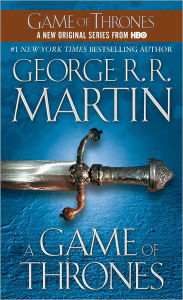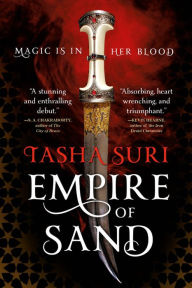Three Real Historical Dynastic Struggles Ripe for Fantasy Adaptation
 Tasha Suri knows from adapting history into fantasy: her debut novel Empire of Sand—one of our favorite books of 2018—is inspired by the real world history of Mughal India. Today, she joins us to talk about three real histrical conflicts from non-Western history that are ripe for fantasy adaptation.
Tasha Suri knows from adapting history into fantasy: her debut novel Empire of Sand—one of our favorite books of 2018—is inspired by the real world history of Mughal India. Today, she joins us to talk about three real histrical conflicts from non-Western history that are ripe for fantasy adaptation.
A Game of Thrones (A Song of Ice and Fire #1)
A Game of Thrones (A Song of Ice and Fire #1)
In Stock Online
Paperback
$8.99
$9.99
Chock full of rightful heirs, lost princes, scheming nobility, heated sibling rivalries, murders and battles and epic last stands galore, dynastic wars are the stuff epic fantasy is made of. If you’ve ever read a tale that touches on the struggle for power between royal siblings, cousins or branches of a family, you’ve read an echo of real-word history twisted inside a fantastical skin.
Chock full of rightful heirs, lost princes, scheming nobility, heated sibling rivalries, murders and battles and epic last stands galore, dynastic wars are the stuff epic fantasy is made of. If you’ve ever read a tale that touches on the struggle for power between royal siblings, cousins or branches of a family, you’ve read an echo of real-word history twisted inside a fantastical skin.
George R. R. Martin has talked about the fact that A Song of Ice and Fire is inspired by the real-life historical Wars of the Roses, in which the York and Lancaster families vied for the throne of England. Although there are still depths to plumb in European history—honestly, there is no shortage of war and suffering to work with—non-western history is rich with untapped inspiration for epic fantasy.
There are endless examples of real-life, non-western dynastic struggles that have everything a good novel needs: bad parenting, bitter siblings, sons who should have ruled (but didn’t), maybe-possibly-murders, definitely-actually-murders, ferocious mothers, and copious lashings of inevitable tragedy. In royal dynasties without primogeniture—the tradition wherein the firstborn son inherits the right to rule—the potential drama ramps up to eleven.
The sons of Suleiman the Magnificent
The Ottomans made a fine art of dynastic struggles. Sultans traditionally had their heirs with their slave-concubines rather than legal wives, one son to one concubine. Advised and supported by their mothers and tutors, granted provincial governorships to hone their political and military acumen, the sons of the sultan were all equally trained from birth for the battle that would ensue on their father’s death. Only one son—the best supported, the canniest, the most cut-throat– would prove himself the victor, strong enough to seize the sultanate. His brothers and nephews would all be put to death. Strangled, ideally, with a silk cord.
No one can say the Ottomans didn’t try and make their fratricide tidy.
The struggle between the sons of Suleiman the Magnificent was nowhere near as neat. Love shattered the tidy, bloody equality of Ottoman inheritance. Suleiman had four sons with one single slave-concubine, a woman named Hürrem, who later became his legal wife. While Suleiman’s eldest son, child of a concubine named Mahidevran, had a mother dedicated to his survival, his children by Hürrem grew up with a mother with divided loyalties… and with the knowledge that they would have to murder their full-blooded siblings if they wanted to survive.
The dynastic struggle between the men, their father and their mothers was vicious, personal and bloody, fuelled by paternal favoritism, sibling rivalry and a mother’s love. Suleiman had his eldest son Mustafa – beloved of the populace and janissaries, by all accounts the ideal heir—executed. Hürrem was widely blamed for engineering Mustafa’s fate, sacrificing the “rightful heir” to save her own children from death. Two of her own sons died, of heartbreak and smallpox respectively. In the end, only two potential heirs remained, both of them Hürrem’s children. One fled to Iran, but was eventually strangled on his father’s orders—alongside all five of his sons—leaving only Selim, kindly dubbed by the cold eyes of history with the moniker of “the drunkard” or “the sot,” standing.
The Slave Dynasty and the Forty
In the Delhi Sultanate, you didn’t have to be from a rarefied bloodline to become sultan. Sultan Iltutmish rose from slavery all the way to the throne. He was the third sultan of the slave dynasty—so-called because many of its rulers were manumitted slaves. But being sultan was a dangerous business, and although it came with many perks, a long lifespan wasn’t one of them. For the potential heirs of the sultanate, the elite nobility—sinisterly known as The Forty—were just as dangerous to their survival as family.
On his deathbed, Iltutmish named his daughter Raziya as his heir, claiming his sons weren’t fit the job. The nobility didn’t think much of being ruled by a woman, but they soon found themselves agreeing with Iltutmish’s assessment. Three of Iltutmish’s sons were crowned, found wanting, and executed in the span of a decade. Raziya briefly took the power her father had promised her, seizing it from her brother Firuz and proving herself a worthy ruler—but she continued to troublingly insist on being a woman in the general direction of the nobility, and was disposed of just like her siblings after a mere three year rule.
Presumably rather short on people willing to be sultan, the nobility handed Iltutmish’s grandson the title. Sultan Masud sensibly kept his nose out of politics and left the business of ruling to his noble advisor, ensuring at least one of the nobility gained what they’d wanted all along: total power without the inconvenient red bullseye of a title.
Dara Shikoh and Aurangzeb
Empire of Sand
Empire of Sand
By Tasha Suri
In Stock Online
Paperback $17.99
The Mughal rulers of north India were descendants of the Timurids, who believed that not only sons but all male descendants of Timur had a right to fight for the throne. Fortunately, by the time of Emperor Shah Jahan, the Mughals had tidied their inheritance laws up somewhat: only Shah Jahan’s sons could take his throne. Less fortunately, he had four who survived to adulthood, all of them hungry for power.
The Mughal rulers of north India were descendants of the Timurids, who believed that not only sons but all male descendants of Timur had a right to fight for the throne. Fortunately, by the time of Emperor Shah Jahan, the Mughals had tidied their inheritance laws up somewhat: only Shah Jahan’s sons could take his throne. Less fortunately, he had four who survived to adulthood, all of them hungry for power.
Every time a Mughal Emperor died, his sons inevitably flung themselves with great, chaotic, fumbling enthusiasm into civil war, throwing the empire into a state of teetering instability. Shah Jahan was singularly unlucky because sons made a play for the throne while he was still alive. Struck down by an illness they were sure would kill him, Shah Jahan survived—and lived the rest of his years in imprisonment.
The battle between two of his sons—the intellectual and cultured Dara Shikoh and the pious war veteran Aurangzeb—was the bitterest of sibling rivalries on the largest possible stage. Dara Shikoh was loved by his father and ill-suited to war; Aurangzeb was unloved and ignored, but a keen and ruthless strategist, who fuelled his ambitious drive for the throne with a deep well of pure loathing. When Aurangzeb captured Dara Shikoh, he paraded his brother through the streets in filth and chains before his execution. Dara Shikoh’s son suffered an even worse fate: imprisonment and a slow, shameful death by opium poisoning.
Aurangzeb was the victor, but like Sultan Selim, he is remembered with little fondness, as a villain and a despot. He was the last of the “Great Mughals”—after him came the slow, steady decline of the empire.
Victory, in these complex familial wars without the law of primogeniture to stem the flow of blood, is hard won. It is won by betrayal and bitterness, love and trickery. It is won by the strongest, but not always by the best, and it never tastes quite as sweet as hoped. These wars of succession are rich, vibrant fuel for the epic fantasies of the future. After all, I think we can all agree: royal fratricide is compelling, but royal fratricide with dragons is utter magic.
Tasha Suri was born in London to Punjabi parents. She studied English and Creative Writing at Warwick University, and is now a cat-owning librarian in London. A love of period Bollywood films, history, and mythology led her to write South Asian-influenced fantasy. Find her on Twitter @tashadrinkstea. Her debut novel, Empire of Sand, is available now.

